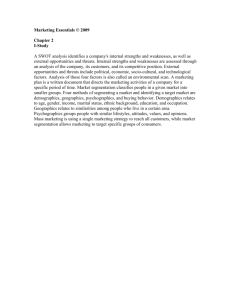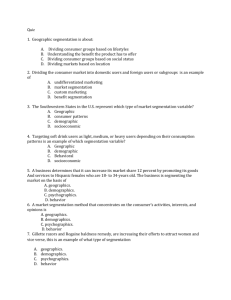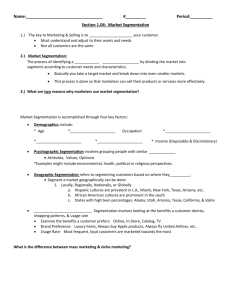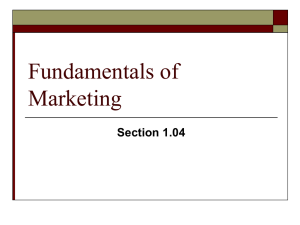Market
advertisement
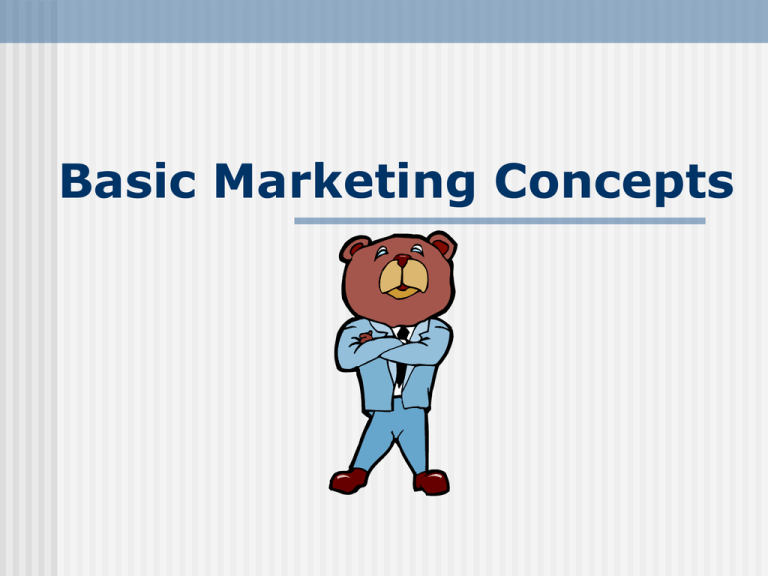
Basic Marketing Concepts Customers vs. Consumers Customers BUY the product. Consumers USE the product. What is a Market? All potential customers who share common needs and wants, and who have the ability and willingness to buy the product, are considered a market. The Marketing Concept U.S. Game Console Market A market can be described as the people who are potential customers of a product, as well as by the classification of a product in a category. Would you be considered part of the market for game consoles? Why or why not? What other markets are you part of? Target Marketing Focusing all marketing decisions on a very specific group of people who you want to reach. Customer Profile Includes information about the target market with regard to the age, income level, ethnic background, occupation, attitudes, lifestyle, or geographic residence of the targeted customers. Marketing Mix The 4 P’s 1. 2. 3. 4. Product Place Price Promotion Product Strategy What product to make How to package it What brand name to use What image to project Place Strategies How and where a product will be distributed Price Strategies Reflects what the customers are willing and able to pay. Promotion Strategies How will the customer be told about the product What will the message be When and where will it be delivered With what inducements Marketing Mix for a New Juice: Tropicana’s Light ‘n Healthy Juice Graphic Organizer The Marketing Mix The Marketing Concept Marketing Research Product Marketing Segmentation Price Consumers Place Promotion Market Segmentation What You'll Learn Market segmentation and the four methods commonly used to segment a market Current demographic, psychographic, and geographic trends Market Segmentation Why It's Important Businesses must know who their customers are to achieve success. In other words, they must know their markets. This section will introduce you to the U.S. marketplace and the different ways businesses classify and characterize its segments. Market Segmentation A way of analyzing a market by specific characteristics in order to create a target market May segment a market by: 1. Demographics 2. Psychographics 3. Geographics 4. Product benefits Demographics Statistics that describe a population in terms of personal characteristics Age Gender Income Ethnic background Education Occupation Age When marketers study age, they classify everyone according to certain generations The last 3 generations were: Baby Boom Generation Generation X Generation Y Baby Boom Generation Born million) between 1946-1964 Large (76 size Great spending power – 51% of the wealth Generation X Born million) between 1965-1976 Savvy (40 and skeptical consumers Better educated Financially cautious and conservative Generation Y Born between 1977 & 1997 (77 million) Computer Revolution $130 million in spending power Influences $250 million in purchases Gender Gender neutral products may use different advertising media and messages when trying to reach men and women. Market Segmentation Demographics: Gender Companies can expand their markets by marketing to the other gender, or by marketing their products differently to men and women. Example: Jockey entered the women’s market with Jockey underwear for women and doubled its sales. Income Disposable: Money left after taking out taxes Necessity items Discretionary: Money left after paying for basic living necessities such as food, shelter and clothing Luxury items Market Segmentation Demographics: Ethnicity Marketers often segment the market by ethnicity. The three largest ethnic groups within the United States are African-Americans, Hispanics, and Asian-Americans. These three groups will account for 33 percent of the U.S. population in 2005. Market Segmentation Census 2000 The United States conducts a census every ten years to determine the characteristics of the population. Which ethnic group is declining? Which ethnic groups are increasing? What effects will these ethnic changes have on marketing in the United States? Psychographics Studies of consumers based on social and psychological characteristic Attitudes Values Lifestyles Market Segmentation Geographics Geographics refers to segmentation of the market based on where people live. Marketers study geographics in relation to: ethnic concentrations age ethnic background income Geographics Based on where people live Local markets Regional markets National markets Global markets Product Benefits Companies market benefits, not simply the physical characteristics of a product. Thinking Critically Many women's magazines like Glamour and Elle publish advertisement for men's cologne. Explain the rationale for this practice. Basic Marketing Concepts THE END
